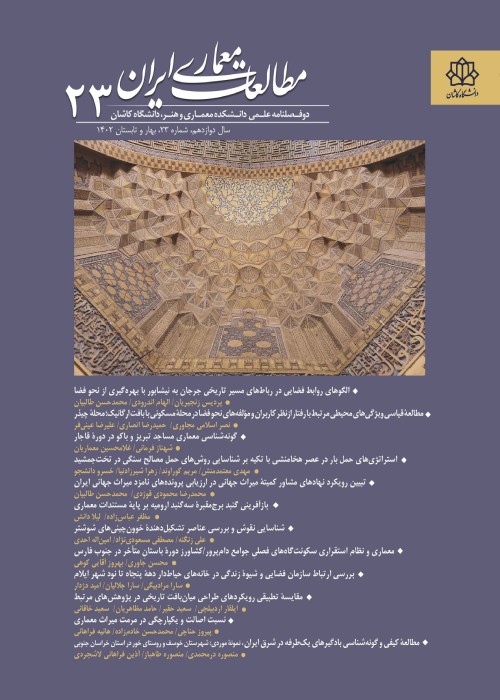A Comparative Study of Iranian Gardens in Sassanid and Islamic Era Based on Described Heavens
Author(s):
Abstract:
Gardens as simulacrums of Heaven have been supposed sacred in Iranians’ beliefs. Despite the common notion that Iranian gardens have had an invariant identity and template over time، the main features of the garden have been very variable in different periods. Physical diversities have become more obvious and sensible according to religious ritual changes which offer different definitions and characteristics for ideal paradise. This study aims to investigate the main features of Sassanid gardens، achieve the overall pattern of them and recognize their changes under the influence of Islamic era. In this way the main cause of physical differences is determined according to the various characteristics of an ideal haven in Zoroastrianism and Islam religions. In this paper، citing religious teachings to the Avesta and the Holy Quran and other sources، to describe the characteristics mentioned in the Gardens will be explained. Then comparative method is used to verify the theoretical foundations of Iran during Sassanid and Islamic period to adapt the components and elements of Persian Gardens to these theoretical foundations (Zoroastrian and Muslim). This method allows us to compare the characteristics of Sassanid and Islamic gardens with the main features of Ideal gardens described in Avesta and Quran. In addition، the physical diversities under the effect of different theoretical foundations are determined. Studies show gardening and garden art is a fixed compartment of all cultures and its evolution is influenced by functionality and religious concepts. Characteristics and symbols associated with garden architecture are on the basis of religious Beliefs and the characteristics of ideal heaven. The differences in theoretical part results in various architectural characteristics: nature was considered sacred in religions such as M. (Mitrayi)، Mzdysna and Zoroastrian، but the arrival of Islam، respect for nature was replaced by it’s consecration. Consequently، significant physical changes in terms of extroversion – introversion، location، number of floors of the palace and… are observed in Persian gardens. Studies indicate that Sassanid gardens are more introverted than Islamic ones. However، defining special boundaries for gardens became popular in Islamic era. There are other physical differences such as plan division، axes، number of floors and etc. between the gardens of these two eras.
Keywords:
garden , Paradise , Sassanid , Zoroastrian , Islam , theoretical ideas
Language:
Persian
Published:
Journal of Iranian Architecture Studies, Volume:3 Issue: 5, 2014
Pages:
57 to 79
magiran.com/p1311566
دانلود و مطالعه متن این مقاله با یکی از روشهای زیر امکان پذیر است:
اشتراک شخصی
با عضویت و پرداخت آنلاین حق اشتراک یکساله به مبلغ 1,390,000ريال میتوانید 70 عنوان مطلب دانلود کنید!
اشتراک سازمانی
به کتابخانه دانشگاه یا محل کار خود پیشنهاد کنید تا اشتراک سازمانی این پایگاه را برای دسترسی نامحدود همه کاربران به متن مطالب تهیه نمایند!
توجه!
- حق عضویت دریافتی صرف حمایت از نشریات عضو و نگهداری، تکمیل و توسعه مگیران میشود.
- پرداخت حق اشتراک و دانلود مقالات اجازه بازنشر آن در سایر رسانههای چاپی و دیجیتال را به کاربر نمیدهد.
In order to view content subscription is required
Personal subscription
Subscribe magiran.com for 70 € euros via PayPal and download 70 articles during a year.
Organization subscription
Please contact us to subscribe your university or library for unlimited access!




